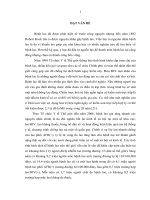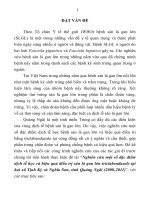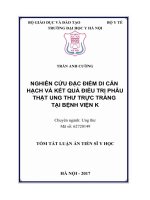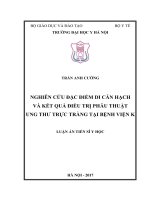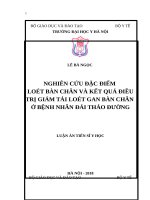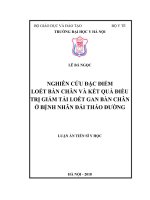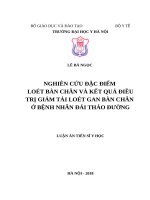Nghiên cứu đặc điểm dịch tễ học và kết quả điều trị nhiễm nấm trên bệnh nhân bỏng nặng tại bệnh viện bỏng quốc gia (2017 2019) tt tiếng anh
Bạn đang xem bản rút gọn của tài liệu. Xem và tải ngay bản đầy đủ của tài liệu tại đây (237.96 KB, 24 trang )
1
INTRODUCTION
Burns are a common trauma. Burn patients have a high risk of
infection due to many different agents such as bacteria, fungi ... Up to
now, infection is still one of the leading causes of death in burn
patients.
Fungal infections in burn patients have different degrees such
as fungus growing on the lesion surface or deeply invading healthy
tissue or sepsis. Candida is the most common cause in addition to
some types of mould such as Aspegillus, Fusarium, Mucor…. There
is emerging of resistance to antifungal drugs which occur in different
species of causative fungi and different antifungals.
Every year in Vietnam there are thousands of patients who
suffer from burns and hundreds of them have to be treated in the
Intensive Care Unit (ICU). However fungal infections in burn
patients have received little attention so far. Therefore, we carry out
the thesis "Study on epidemiological characteristics and treatment
results of fungal infections in patients with severe burns at the
National Hospital of Burn (2017 - 2019)" with 3 objectives:
1. Determine the prevalence and associated factors of fungal
infection in patients with severe burns (March 2017 - December
2019).
2. Determine the fungal species composition in patients with
severe burns by morphological and molecular biology methods.
3. Evaluate the sensitivity of the isolated strains to some
antifungal drugs and results of treatment of fungal infections in
severely burned patients.
2
* NOVELTY AND SCIENTIFIC SIGNIFICANCE OF THE THESIS
1. This is the first study in Vietnam to determine the prevalence of
colonization and invasive fungal infections as well as related factors
in patients with severe burns.
2. Applying morphological methods and molecular biology
techniques to determine the fungal species composition isolated from
burn patients.
3. Evaluate the sensitivity of Candida species to antifungal drugs
commonly used in treatment.
4. Develop treatment regimens and evaluate the results of antifungal
therapy in burn patients.
THESIS STRUCTURE
The thesis consists of 120 pages divided into the following sections:
Introduction (2 pages), literature review (33 pages), study subjects
and methods (22 pages), study results (32 pages), discussions (28
pages), conclusions (2 pages), and recommendations (1 page). There
are 167 references, 33 tables and 19 figures.
Chapter 1. LITERATURE REVIEW
1.1. The prevalence and related factors of fungal colonization and
infection in burn patients
1.1.1. Definition, classification
1.1.1.1. Definition and characteristics of burn injury
A burn is a type of injury/ wound caused by non-mechanical factors but
by elements of heat (heat/cold), chemistry, radiation (ionization, nonionization ...). Burns caused by heat compose most of the patients. A
3
burn is considered a disease with different stages including acute
reaction, infection - intoxication with complications and recovery phase.
1.1.1.2. Definition and medical role of fungus
Fungi are eukaryotic, cell-walled, heterotrophic, and spore-reproducing
organisms. Fungi can cause fungal diseases of the skin or subcutaneous
and systemic disease that can affect the blood or deep-seated, visceral.
1.1.1.3. Definition, classification of fungal infections in burn patients
Fungal colonization (FC) was defined as fungi isolated from a nonsterile body sites ((respiratory fluids, faeces, urine ...).
Fungal wound/burn infection (FWI) was defined as the presence of
fungus in the healthy layer of the wound.
Fungemia is the bloodstream infection caused by fungus.
Invasive fungal infections (IFI) include FWI and fungemia.
1.1.2. Prevalence of fungal infection in patients with burns
1.1.2.1. Prevalence of fungal colonization
An Italian study on patients with ICU found that 92.3% of patients had
a fungal infection on the admission of the ICU.
1.1.2.2. Prevalence of fungal wound infection
Prevalence of fungal wound infection ranges from 2 - 20%.
1.1.2.3. Prevalence of fungemia
Prevalence of fungemia ranges from 3 - 5% among burn patients.
1.1.3. Factors related to fungal infection
1.1.3.1. Factors of burn pathology
Post-burn pathological changes associated with fungal infection. Heatinduced skin damage and impaired local and systemic immune so burn
patients are at risk of infection. Bacterial penetration of the burn occurs
4
early. Fungal infections usually begin to appear in the second week and
get the highest prevalence in the third and fourth week after the burn.
1.1.3.2. Factors of burn treatment
Burn patients usually undergo multiple interventions such as surgeries,
blood transfusions, total parenteral nutrition (TPN) and kidney
replacement which weaken the patient's immune system thereby
facilitating fungal infections after burns.
1.1.3.3. Factors of environment
The risk of fungal infection from the polluted surrounding environment
of patients in burn care units
1.2. Fungal identification techniques and species composition in
burn patients
1.2.1. Fungal identification techniques
1.2.2.1. Fungal identification techniques based on morphological
characteristics
- Identification of yeast: the occurrence of the spores; germ tube,
biochemical reactions or the use of a chromogenic medium. There are
several automated identification systems like Vitek II.
- Identification of mould: based on macroscopic and microscopic
morphological features with the help of commonly used keys.
1.2.2.2. Identification of fungi by molecular biology
Previously, many techniques were applied to identify fungal species
such as RFLP, RAPD ... Nowadays the sequencing of internal
transcribed spacer regions (ITS1 / ITS2) or other regions is applied.
1.2.2. Fungal species composition in burn patients
5
Common fungal agents causing colonization are Candida, Aspergillus,
Fusarium, Mucor ... C. albicans is the most common but the rate of nonalbicans tends to increase.
FWI: yeast is the leading cause of FWI followed by some moulds like
Aspergillus, Syncephalestrum and Fusarium.
Fungemia: The five most common species that cause IFI are C.
albicans, C. tropicalis, C. glabrata, C. parapsilosis, and C. krusei.
Candida species composition is different in different geographical
location, the patient population as well as a history of antifungal drugs.
Some studies on the composition of fungal species in Vietnam
Some studies at the National Hospital of Burn found that C. albicans is
the causative agent among all burn patients with fungemia.
1.3. The sensitivity of the fungus to some antifungal agents and
results of fungal infection treatment in burn patients
1.3.1. Antifungal agents
1.3.1.1. Polyene: amphotericin B
1.3.1.2. Azole: fluconazole, voriconazole.
1.3.1.3. Echinocandins: caspofungin, micafungin
1.3.1.4. Flucytosine (5-FC): flucytosine.
1.3.2. The sensitivity of the fungus to some antifungal agents
1.3.2.1. Methods for antifungal sensitivity testing
The two available reference technique for antifungal sensitivity testing
are CLSI (US) and (EUCAST) (Europe). There are some commercial
kits such as Etest, Vitek 2, Sensititre Yeast One which have shown
consistent results with the reference methods.
1.3.2.2. Susceptibility of common fungi to some antifungals
6
- The sensitivity of Candida to antifungals
C. albicans is usually sensitive to azoles and amphotericin B while C.
glabrata is less susceptible to azoles and amphotericin B. C. krusei is
less susceptible to all drugs.
Echinocandins are effective against Candida, including azole-resistant
strains and echinocandins resistance among Candida strains are very rare
+ Sensitivity of Aspergillus: azole resistance already exists.
Fusarium is usually resistant to amphotericin B.
1.3.3. Treatment of fungal infections in burn patients
1.3.3.1. Treatment strategies
Prophylactic: an antifungal agent is administered to patients at risk for
IFI but in the absence of any attributable signs and symptoms. Empiric
treatment is defined as an antifungal treatment in patients at risk of IFI
and with established clinical signs and symptoms. Pre-emptive treatment
is defined as an antifungal treatment in patients at risk of IFI and a
diagnostic workup have yielded results suspicious of IFI. Targeted
treatment may be applied if diagnostic criteria allow for definite
pathogen identification.
+ Treatment of invasive candidiasis: amphotericin B or caspofungin
and de-escalation with an azole.
+ Treatment of invasive aspergillosis: triazole, echinocandin
(caspofungin, micafungin) or amphotericin B.
+ Treatment of invasive fusariosis: voriconazole
1.3.3.2. Evaluate the results of fungal infection treatment in burn patients
Routine clinical and subclinical parameters, fungal tests, the occurrence
of severe complications, mortality or survival.
7
Chapter 2 STUDY SUBJECTS AND METHODS
2.1. Subject and method for objective 1: Prevalence and related
factors of fungal infection in patients with severe burns
2.1.1. Subjects
- Severely burned patients due to heat at the National Burn Hospital.
2.1.2. Time and site of the study
- Study time: From March 2017 to December 2019.
- Site: ICU, NHB; mycological laboratory, Department of Parasitology,
Vietnam Military Medical University.
2.1.3. Methods
2.1.3.1. Study design: Descriptive, analytic, prospective research.
2.1.3.2. Sample size
According to the formula for a ratio, the calculated sample size was
385 patients. The thesis collected information of 400 patients
2.1.3.3. Sampling method
All patients who met the study criteria were selected.
2.1.3.4. Research content
Determine the prevalence of colonization/infection and related factors
in patients with severe burns.
2.1.3.5. Methods of determining and measuring variables
2.1.3.6. Variables
- Prevalence of FC, FWI and fungemia.
Colonization index (CI), heavy colonization: when a CI index is ≥ 0.5.
- Factors related to fungal colonization/infection in burn patients.
2.1.3.7. The techniques applied in the study
- Examination, evaluation and description of burn injuries.
8
- Collection of samples: weekly according to routine procedures.
- Detection of fungi in collected samples: direct examination, staining, culture.
- Techniques to determine factors related to fungal infection.
2.1.3.8. Materials
- Medical record.
- Tools for collecting specimens, examination and isolation of fungi.
2.1.3.9. Data analysis and processing: according to biomedical
statistics by SPSS 16.0 software.
2.2. Subject and method for objective 2: Determine the fungal
species composition in patients with severe burns
2.2.1. Subjects
- Fungi: isolated from the burn patients involved in objective 1.
2.2.3. Methods
2.2.3.1. Study design: an experimental study.
2.2.3.2. Sample size: All fungal isolation from the burn patients
involved in objective 1.
2.2.3.3. Sampling method
- All isolated strains were subjected to identification based on
morphological and biochemical features.
- Identification by molecular techniques: strains isolated from sterile
samples, identified as rare yeast or representatives of common species.
2.2.3.6. The techniques applied in the study
- Identification of fungi by histopathological examination and
morphological characteristics with the help of common keys. Yeasts
were identified by Brilliance Candida Agar medium and Vitek 2 system.
9
- Molecular biology technique: amplification of ITS region with
primers ITS1, ITS4, sequenced and compared with those in GenBank.
2.3. Subject and method for objective 3
2.3.1. Evaluate the sensitivity of the isolation to some antifungals
2.3.1.1. Subjects
- 184 Candida strains isolated from the burn patients.
2.3.1.5. The techniques applied in the study
Antifungal susceptibility testing (AST) was performed with
Vitek2Compact (Biomerieux, France).
2.3.1.6. Variables
- Levels of susceptibility (S (susceptible), I (intermediate) and R
(resistant) according to species-specific clinical breakpoints (CBP)
established by the Clinical and Laboratory Standards Institute (CLSI).
2.3.2. Evaluation of treatment outcomes for fungal infections in
patients with severe burns
2.3.2.1. Subjects:
- Severely burned patients due to heat at the National Burn Hospital.
2.2.2.3. Methods
- Study design: evaluate the effectiveness of the therapy regime.
- Sample size: All patients who indicated antifungal drugs.
- Treatment indication
+ Fungal-oriented treatment: patients at risks for IFI, have fever, heavy
colonization; Ostrosky-Zeichner prediction rules, Candida score> 2.5.
+ Fungal-targeted treatment: patients with definite diagnose of IFI.
- Treatment regimen: fluconazole, caspofungin for patients infected
with yeast species and voriconazole for those with mould.
10
Chapter 3 RESULTS
3.1. Results of the prevalence and related factors of fungal
infections in patients with severe burns
3.1.1. Information about the subjects
The average age was 29.74 years old. The age group with the highest
percentage is children ≤ 10 years old and who from 31-40 years old. Men
were more affected than women (male / female = 3.49 / 1).
The overall burn area is 44.39%; 17.72% of deep burns.
The average length of hospital stay was 36.73 days, ICU stay was
18.39 days. The subjects had many serious consequences and treatment
interventions. The mortality rate was 19.50%.
3.1.2. Prevalence of fungal colonization and infection
Table 3.4. The prevalence of fungal colonization/infection
Fungal colonization/infection
Yes
FC (309)
(360) FC FWI Yeasts
n
Percentage (%)
309
77.25
22
5.50
and
Molds
11
2.75
IFI
Yeasts and moulds
3
0.75
Fungemia
12
3.00
Fungemia + FWI
3
0.75
40
10.00
(51)
No (40)
There were 90% of patients with fungal including 12.75% of
patients with IFI. All patients with IFI had fungal colonization.
The prevalence of fungal colonization/infection in male and female
patients was not statistically significant.
11
Table 3.6. Prevalence of fungal colonization/ infection by age group
Age groups
n
Colonization
Infection
n1
%
n2
%
1 - 15 (1)
113
97
85.84
6
5,31
16 – 65 (2)
267
244
91.39
42
15,73
66 – 94 (3)
20
19
95.00
3
15,00
400
360
100
51
100
Total
p
0,192
0.019
The rate of IFI in the 1-15-year-old group was lower (p <0.05).
3.1.3. Factors related to fungal infection
3.1.3.1. Factors related to fungal colonization
Table 3.9. Multivariate analysis of factors related to fungal colonization
FC
Factors
Yes
No
OR (CI 95%)
Severe
Yes
306
27
1.620
infection
No
54
13
(0.701 - 3.746)
162
9
1.355
No
198
31
(0.539 - 3.406)
Yes
59
1
4.758
No
301
39
(0.594 - 38.139)
Yes
277
23
1.402
No
83
17
(0.626 - 3.138)
Hyperglycemia Yes
Hemodialysis
TPN
p
0.259
0.518
0.142
0.412
On multivariate analysis, no factors made the patients a higher risk
of fungal colonization.
The rate of FC has little change over time.
12
3.1.3.2. Factors related to invasive fungal infection
Table 3.14. Multivariate analysis of factors related to invasive
fungal infection
IFI
Factors
Severe infection
Prolonged ICU
stay
Renal failure
Hyperglycemia
Catheter
Hemodialysis
TPN
Mechanical
ventilation
Immunosuppressive therapy
Heavy
colonization
Yes
No
Yes
No
Yes
No
Yes
No
Yes
No
Yes
No
Yes
No
Yes
No
Yes
No
Yes
No
Yes
No
OR (CI 95%)
49
2
41
10
21
30
45
6
48
3
23
28
50
1
30
21
45
6
45
6
284
65
166
183
57
292
126
223
228
121
38
311
250
99
94
255
165
184
197
152
0.250
(0.035 - 1.787)
2.572
(1.098 - 6.023)
0.899
(0.352 - 2.293)
4.067
(1.333 - 12.408)
0.976
(0.219 - 4.350)
2.257
(0.892 - 5.709)
4.588
(0.389 - 54.155)
0.738
(0.305 - 1.789)
2.398
(0.832 - 6.913)
2.790
(1.071 - 7.265)
p
0.167
0.030
0.823
0.014
0.974
0.086
0.226
0.502
0.106
0.036
Hyperglycemia, prolonged ICU stay and heavy Candida spp.
colonization was found to be independently predictive of IFI on the
multivariate model. The rate of IFI increase with time.
13
3.2. Results on fungal species composition in burn patients
3.2.1. Composition of species causing fungal colonization
Table 3.15. Composition of yeast and mould in burn patients
Yeast/mould
n
(%)/colonized
(%)/total of
(n=360)
patients (n=400)
Yeast
360
100
90
Mould
28
7.78
7.00
Combination
28
7.78
7.00
100% of colonized patients had yeast. 7.78% of patients infected
with a combination of yeast and mould.
Table 3.16. Distribution of yeast species isolated
Species
n
%
C. albicans
151
41.94
C. tropicalis
164
45.56
C. parapsilosis
23
6.39
C. lusitaniae
4
1.11
C. glabrata
5
1.39
C. dubliniensis
4
1.11
C. famata
3
0.83
C. ciferrii
2
0.56
C. krusei
2
0.56
C. tropicalis + C. duobushaemulonii
1
0.28
C. parapsilosis + Kodemaea ohmeri
1
0.28
Among 11 isolated species, C. tropicalis (45.56%) accounted for the
highest proportion, followed by C. albicans (41.94%).
14
Table 3.18. Distribution of mould species isolated
Species
n
(%)/colonized
(%)/colonized with
(n=360)
mould (n=28)
A. fumigatus
11
3.06
39.29
A. oryzae
6
1.67
21.43
A. flavus
6
1.67
21.43
A. chevalieri
2
0.56
7.14
A. nomius
2
0.56
7.14
F. solani
1
0.28
3.57
Aspergillus accounted for the main proportion (27/28 cases =
96.43%). Besides, Fusarium solani was also encountered.
A. fumigatus species is most common among mould (39.29%).
3.2.2. Composition of species causing an invasive fungal infection
Table 3.20. Distribution of yeast species causing fungal wound
infection
Percentage (%)
Species
n
Among those with
Among those with FWI
FWI (n=40)
caused by yeast (n=29)
C. tropicalis
20
50.0
68.97
C. albicans
7
17.5
24.14
C. parapsilosis
1
2.5
3.45
K. ohmeri
1
2.5
3.45
The most common yeast causing FWI was C. tropicalis (50,0%), C.
albicans (17,5%).
15
Table 3.21. Distribution of mould species causing fungal wound
infection
Percentage (%)
Species
n
Among those with
Among those with
FWI caused by mould
FWI (n=40)
(n=14)
A. fumigatus
6
15.00
42.86
A. flavus
3
7.50
21.43
A. oryzae
2
5.00
14.29
A. nomius
1
2.50
7.14
A. chevalieri
1
2.50
7.14
F. solani
1
2.50
7.14
Aspergillus was the main cause of FWI caused by mould (13/14
cases), in addition to F. solani (1/14 cases). The most common
Aspergillus species were A. fumigatus (15%), A. flavus (7.5%).
Table 3.23. Distribution of species causing fungemia
Species
N
Percentage (%)
C. tropicalis
9
64.29
C. albicans
3
21.43
C. parapsilosis
2
14.29
Tổng
14
100
The most common etiologies of fungemia was C. tropicalis
(64.29%), C. albicans (21.43%). C. parapsilosis was also
encountered.
3.3. Results of the sensitivity of the fungi and treatment of
fungal infections in severely burned patients
16
3.3.1. Results of the sensitivity of the fungal isolation
Table 3.24. Susceptibility of Candida species to antifungal drugs
Antifungal
Sensitivity
Intermediate
Resistant
n1
%
n2
%
n3
%
n*
Fluconazol
180
150
83.33
9
5.00
21
11.67
Voriconazol
181
163
90.06
7
3.87
11
6.08
Caspofungin
181
177
97.79
3
1.66
1
0.55
Micafungin
181
180
99.45
1
0.55
0
0.00
Amphotericin B
183
177
96.72
0
0.00
6
3.28
Flucytosin
182
172
94.51
6
3.30
4
2.20
The echinocandin drugs (caspofungin and micafungin) had the
highest sensitivity. The lowest susceptibility rate was azole drugs:
fluconazole
(83.33%),
followed
by
voriconazole
(90.06%).
Flucytosine (94.51%) and amphotericin B (96.72%) had a relatively
high rate of sensitivity.
C. albicans was not resistant to echinocandin. The rate of sensitivity
to fluconazole was low (86.49%), The rate of sensitivity to
flucytosine, voriconazole and amphotericin B was about 95%.
The rate of C. tropicalis resistant to azoles was high, and resistant to
echinocandin and amphotericin B was low.
Other fungi were not resistant to echinocandin.
3.3.2. Results of the treatment of fungal infections in severely
burned patients
Candida score were all above 3. The change between groups was
not significant (p> 0.05). CI index after treatment decreased
17
compared to that before treatment.
The average clearance time in patient's biopsy tissue and blood was
12.71 days (7 to 23 days) and 8.11 days (4 to 12 days) respectively.
Table 3.32. The outcome of treatment of invasive fungal infection
Diagnosis
Survive
n
Mortality
n
%
n
%
FWI
31
24
77.42
7
22.58
Fungemia
7
2
28.57
5
71.43
FWI + Fungemia
3
1
33.33
2
66.67
41
27
65.85
14
34.15
Total
Among those with IFI and antifungal treatment, there were
65.85% of the patients had succeeded in treatment.
Table 3.33. Comparison of mortality and duration of fungal
treatment in patients with invasive fungal infections
Parameters
Mortality
Survive
total
Strateg
Fungal-
n
3
16
19
ies
oriented
%
15.79
84.21
100
Fungal-
n
11
11
22
targeted
%
50.00
50.00
100
Yearly
n
4
13
17
of
%
23.53
76.47
100
treatme Lately
nt
n
10
14
24
%
41.67
58.33
100
Time
p
0.048
0.383
The outcome of treatment depended on the treatment strategies but
not related to the time of treatment.
18
Chapter 4. DISCUSSION
4.1. Prevalence and related factors of fungal colonization and
infections in burn patients
4.1.1. Prevalence of fungal colonization and infections
4.1.1.1. Prevalence of fungal colonization
There were 90% of patients colonized or infected with fungi, among
them 77.25% had colonization and 12.75% had a combined IFI.
4.1.1.2. Prevalence of fungal wound infection
The prevalence of FWI was low (9.75%) and consistent with other
reports. The low prevalence of FWI was also concordance with the low
rate of isolation of fungi on the wound surface.
4.1.1.3. Prevalence of fungemia
The prevalence of fungemia was 3.75% and in line with other studies.
The prevalence of fungemia in the current study is higher compared to
the prevalence reported at Cho Ray hospital, Ho Chi Minh city (2.09%).
However, in the present study, only those with severe burn and treated at
ICU were involved so that they may have a higher risk of fungemia.
4.1.2. Factors related to fungal colonization/infection in burn patients
4.1.2.1. Factors related to fungal colonization
The univariate analysis presented severe infection, prolonged ICU stay,
hyperglycemia, dialysis and TPN as significant predictors of FC.
However, the multivariate analysis showed that there were no factors
predicted FC in burn patients. This would be reasonable because most
colonized patients having isolation on the ICU admission and the rate of
FC was nearly steady over the time those patients were in the ICU. This
result is consistent with some other studies.
19
4.1.2.2. Factors related to fungal invasive infection
Several factors were found to be associated with IFI on univariate
analysis, nevertheless, on multivariate analysis only hyperglycemia,
prolonged ICU stay and heavy Candida spp. colonization was
independently predictive of IFI.
4.2. Species composition of fungal isolation
4.2.1. Species composition causing fungal colonization
All colonized patients were colonized with yeast and some colonized
with both yeast and mould. This result is also consistent with most
reported studies.
4.2.1.1. Species composition of yeast
10 species of Candida were discovered, of which C. tropicalis was the
most common (45.56%) followed by C. albicans (41.94%). C. albicans
is still a common species but not accounts for over 50%; This result
follows the trends of the decreasing rate of C. albicans and the increasing
rate of non-albicans Candida in the world and Vietnam specifically.
4.2.1.2. Species composition of mould
There were 28 patients (7%) or infected with mould including
Aspergillus (accounted for the most) and Fusarium species. Among
Aspergillus species, A. fumigatus accounted for the majority (2.75%)
along with some other species such as A. oryzae, A .flavus ...
4.2.2. Species composition causing an invasive fungal infection
4.2.2.1. Species composition causing fungal wound infections
- Composition of yeast and mould: Yeast is the leading cause of FWI that
is consistent with some other authors. The high incidence of FWI caused
20
by mould contradicted to the low rate of FC by mould emphasize the
importance of protecting wounds from the contaminated environment.
- Yeast species composition: The most common responsible agent of
FWI was C. tropicalis (43.59%), followed by C. albicans (17.95%) that
was comparable to previous reports.
- Mould species composition: Aspergillus was still the most common
cause of FWI that was consistent with other studies and demonstrated
high virulence of Aspergillus among moulds. A patient infected with F.
solani, the Fusarium species most commonly encountered in humans
4.2.2.2. Species composition causing fungemia
Among agents responsible for fungemia C. tropicalis accounted for the
main proportion (64.29%), followed by C. albicans (21.43%) and C.
parapsilosis. This result is in agreement with some of the reports in
Vietnam showing that C. albicans and C. tropicalis were the most
common Candida isolated from blood.
4.3. The sensitivity of the isolated strains to some antifungals and
results of treatment of fungal infections in severely burned patients
4.3.1. The sensitivity of the isolated strains to some antifungals
- Except for micafungin, the isolated strains showed some degrees of
resistance to the tested drugs. The lowest susceptibility was to
fluconazole, followed by voriconazole, flucytosine, amphotericin B. The
echinocandin drugs had a high susceptibility rate.
+ The lowest rate of sensitivity to fluconazole was and consistent with
some studies showing that azoles, especially fluconazole, had a high rate
of reduced response and drug resistance. In Vietnam, the high rate of
Candida resistance against fluconazole has been reported (57.7%).
21
+ Voriconazole: 90.06% of Candida strains were sensitive to
voriconazole. A study on 271 clinical strains in Singapore found that the
rate of susceptibility to voriconazole was relatively low (86.9%).
+ Echinocandin: has a very high sensitivity rate (98.90% to
caspofungin and 99.45% to micafungin). At present, an echinocandin is
considered the first choice in the treatment of invasive candidiasis.
+ Amphotericin B: the sensitivity rate to amphotericin B was 96.72%.
Resistance to amphotericin B is still rare, possibly due to the fungicidal
nature of the drug that limits the mutation.
+ Flucytosin: 94.51% of the Candida strains were sensitive to
flucytosine which complied with some other reports.
+ Susceptibility of C. albicans: C. albicans strains were not resistant to
echinocandin. This result is this follow the trend described previously
that most strains of C. albicans are sensitive to common antifungals,
however, some strains show the resistance, especially against
fluconazole and flucytosine.
+ Susceptibility of C. tropicalis: the rate of C. tropicalis resistant to
echinocandin was low but to azole were high (fluconazole 15.66%, and
voriconazole 9.88%). Our results seem to highlight that antifungal
resistant rate among C. tropicalis is higher than that of C. albicans.
+ Susceptibility of other Candida species: other Candida species had a
high rate of resistance to antifungals, especially to azoles.
4.3.2. Evaluate the results of treatment of fungal infection in burn
patients
4.3.2.1. Regimen for treatment of fungal infections in burn patients
22
Most patients took the fungal-oriented regimen which was consistent
with other researches. The rate of taking targeted regime was low.
4.3.2.2. Changing of fungal assay
- Candida score: All patients had Candida score above 3 at the all timepoint of evaluation and there was no change of statistical significance.
- CI: CI tended to decrease after antifungal treatment. Even so, fungi
were still isolated from non-sterile samples of patients taking antifungals.
- The time to clear the fungus in the blood was similar to that of some
other reports.
4.3.3.4. Result of treatment
Among 41 patients with IFI receiving antifungals, the survival rate was
65.85% that was equivalent to other reports. The approach is more
important than the timing of treatment. Patients taking fungal-oriented
therapy have a lower mortality rate than fungal-targeted treatment, while
the early treatment does not reduce mortality compared with the late
treatment group.
CONCLUSION
1. Prevalence and associated factors of fungal colonization/infection
in patients with severe burns
- The prevalence: 90% of the patients are colonized with fungi
including 12.75% having an invasive fungal infection (9.25% have
fungal wound infections, 2.75% have fungal infections). The
prevalences are not different by age and sex, except that the
prevalence of invasive fungal infection in children (1-15 years old) is
lower than that of the other age groups.
- Associated factors of fungal colonization/infection
23
Patients with severe burns have a high rate of fungal colonization on
hospital admission and no factors made the patients a higher risk of
fungal colonization.
Hyperglycemia (OR = 4,067), prolonged ICU stay (OR = 2,790)
and heavy Candida spp. colonization (OR = 2,572) is independently
predictive of invasive fungal infection.
2. Fungal species composition in patients with severe burns
Colonization: 100% of colonized patients have yeast isolation, 7.78%
have both yeast and mould. The isolated fungi belong to 17 species,
including 11 species of yeast and 6 species of mould. Among yeast
species, Candida tropicalis accounts for the highest proportion (45.56%),
followed by Candida albicans (41.94%). Aspergillus is the most
common mould (in which Aspergillus fumigatus accounts for 39.29%).
Fungal wound infections: 72.5% of cases are caused by yeasts and
the most common agents are Candida tropicalis (50.0%), Candida
albicans (17.5%). 35% are caused by mould such as Aspergillus
fumigatus (15%), Aspergillus flavus (7.5%), Fusarium solani (2.5%).
Fungemia: Candida tropicalis accounts for the most (64.29%),
followed by Candida albicans (21.43%), Candida parapsilosis
(14.29%).
3. The sensitivity of the isolated strains to some antifungals and
results of treatment of fungal infections
The echinocandin drugs (caspofungin and micafungin) have a high
rate of sensitivity while azole drugs have the lowest sensitivity.
Candida albicans is not yet resistant to echinocandin but 5.19% of
strains are resistant to fluconazole.
24
The Candida non- albicans yeast has a high rate of resistance to
azole and amphotericin B but susceptibility to echinocandin.
- Evaluation of treatment results
Over 67 patients taking antifungals: Candida score is little changed
and colonization index tends to decrease. The average clearance time
in the biopsy tissue was 12.71 days (7 to 23 days); in the blood is 8.11
days (4 to 12 days).
Over 41 patients with invasive fungal infection and take antifungals:
The cure rate is 65.85%. The approach of treatment is more important
than the timing of treatment. Patients taking fungal-oriented therapy
have a lower mortality rate than fungal-targeted treatment, while the
early treatment does not reduce mortality compared with the late
treatment group
RECOMMENDATION
1. Screen for fungi in patients with severe burns, especially among
those with hyperglycemia, prolonged ICU stay.
2. Use of fungal-oriented treatment regimen for patients who have
risk factors (severe burns, hyperglycemia), unexplained fever despite
broad-spectrum antibiotic therapy, heavy colonization (Colonization
index ≥ 0.5), Candida score> 2.5, clinical conditions that meet criteria
for Ostrosky-Zeichner’ clinical prediction rule.
3. Test the susceptibility to antifungals of fungi isolated from
patients with fungal wound infection or fungemia caused by Candida
to select suitable antifungals.
4. Monitor the changing of species composition and susceptibility to
antifungals for appropriate treatment recommendations.
